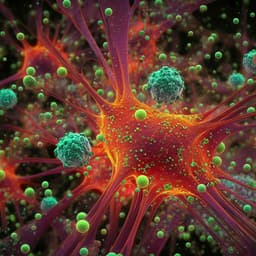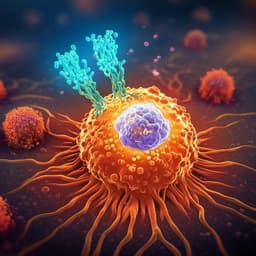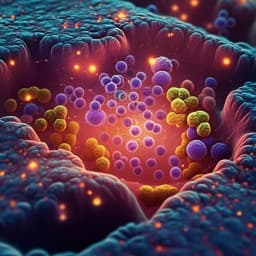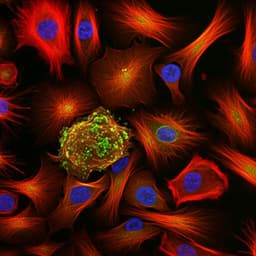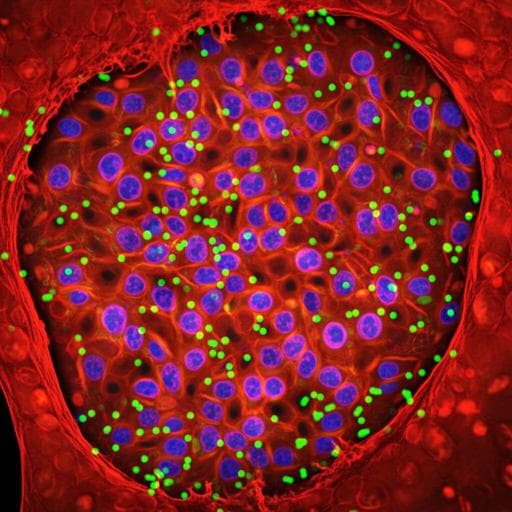
Medicine and Health
Image-seq: spatially resolved single-cell sequencing guided by in situ and in vivo imaging
C. Haase, K. Gustafsson, et al.
Explore the pioneering advancements in spatial and temporal understanding of tissue function through Image-seq technology, developed by leading researchers including Christa Haase and Karin Gustafsson. This innovative approach merges single-cell analysis with spatial organization, unveiling crucial insights in leukemia biology and beyond.
~3 min • Beginner • English
Introduction
Spatial transcriptomics aims to map gene expression within tissue context, overcoming the loss of spatial information inherent to conventional scRNA-seq. Existing imaging-based methods (for example, MERFISH, seqFISH) and capture-based approaches (for example, Slide-seq) provide spatial resolution but are typically applied in vitro or on thin tissue sections, limiting 3D reconstruction and temporal analysis. Section-based methods provide static, 2D snapshots and require inference of dynamics via pseudo-time, and none are integrated with in vivo imaging. The study introduces Image-seq, addressing the question of how to obtain high-quality, single-cell transcriptomes from viable cells with preserved spatial and temporal context in intact tissues, including in vivo settings, to understand cellular organization and disease dynamics such as early AML progression.
Literature Review
The authors review advances in spatially resolved transcriptomics including MERFISH, seqFISH, Slide-seq, and related approaches that map gene expression to spatial coordinates. These methods largely require in vitro application or rely on tissue sectioning, constraining analysis to 2D and limiting extension to intact 3D tissues. They also mention Niche-seq as an exception integrating spatial context with sequencing. Although 3D expression and segmentation in sections have been demonstrated, section thickness and mRNA probe diffusion limit depth. Temporal dynamics must often be inferred via pseudo-time or RNA velocity rather than directly observed, and integration with in vivo imaging has been lacking. Prior bone marrow spatial transcriptomics used laser microdissection of fixed sections with deconvolution by independent scRNA-seq, with no spatially resolved transcriptomic studies of leukemic bone marrow reported.
Methodology
Image-seq platform: A confocal/multiphoton microscope incorporates a second optical path for plasma-mediated femtosecond laser micromachining to ablate bone and create a small access channel (~50 × 100 µm). Requirements include >10 nJ pulse energy with reduced repetition rate (few MHz) to minimize thermal damage. The custom system uses a 1,550 nm femtosecond fiber laser at 5 MHz; frequency doubling to 775 nm for imaging/ablation (1–2 nJ for imaging; 10–15 nJ for ablation), and soliton-shifted 1,880–1,960 nm light frequency-doubled to 940–980 nm for additional imaging. Scanning is achieved with a revolving polygon and galvanometer mirrors, with a variable aperture defining ablation geometry. A micropipette, fluorescently coated for visualization, is inserted at ~20° through the etched channel under image guidance to aspirate target cells; displaced volume controls the number of cells collected (from single cells to thousands). The aspirated sample is expelled to directly create a single-cell suspension. In vivo/in situ workflows: - Regions of interest are identified by intravital multiphoton/confocal imaging; mice undergo transcardial perfusion to reduce RBCs. - Laser ablation removes ~40 µm × 200 µm × 300 µm bone; a ~30–100 µm diameter access channel is created; micropipette is inserted to aspirate cells. - Samples are either loaded directly on a 10x Chromium chip for droplet-based scRNA-seq or stained and sorted by flow cytometry (for targeted populations) into 96-well plates for SMARTseq-v4. - For stromal cell isolation, enzymatic perfusion (collagenases, hyaluronidase, DNase I) and 20 min incubation facilitate recovery of CD45− CXCL12+ stromal cells. - Cell recovery and quality: single-cell targeted recovery efficiency ~70%; typical aspirates contain the target cell plus ~100 surrounding cells; pooled aspirates average ~2,000 cells. Viability averages: calvarium 94%, tibia 92%. Validation and sequencing: - 10x Chromium: 11 Image-seq samples (n=5 mice) and 3 whole calvarial bone marrow (WCBM; n=3) controls. Data processed with Cell Ranger; integrated with Conos; clustered via Leiden; visualized by UMAP; marker genes used for annotation; QC thresholds UMI>800 and mitochondrial ratio<0.2. - SMARTseq-v4: Used for rare AML cells (Hoxa9/Meis1 model) and stromal cells. Alignment with hisat2; counts via featureCounts; Seurat for normalization, SNN graph, UMAP, clustering, differential expression; average ~3.31×10^6 mapped reads and 8,053 genes per AML cell passing QC. - AML imaging-guided selection: Intravital imaging days 1–3 post-transplant identifies proliferating (P), intermediate (IM), and non-proliferating (NP) cavities by fold-change in AML counts. Image-seq aspirates P/IM/NP sites; AML GFP+ cells isolated by FACS for SMARTseq-v4. - Differential expression: DESeq2 used for P vs NP and (P+IM) vs NP; GO enrichment via ClusterProfiler. Additional analyses: - Validation of spatial selectivity using MLL-AF9 model by sampling high-burden vs low-burden regions. - In vivo DPP4 detection by AF568-conjugated antibody and multiphoton imaging; Ki-67/DAPI cell cycle analysis by flow cytometry in DPP4+ vs DPP4− AML cells. - Human AML bulk RNA-seq (OHSU, TCGA Firehose) correlation of genes with DPP4 to assess relevance; GO on overlapping top correlated genes. - Microenvironment studies: Co-culture of AML with stromal/osteolineage cell lines to test induction of DPP4; mapping AML locations to bone remodeling cavity types (D, M, R) using tetracycline/Alizarin Red labeling.
Key Findings
- Image-seq enables viable cell isolation under image guidance from intact tissue, preserving spatial and temporal context. Single-target-cell recovery efficiency ~70%; pooled aspirates average ~2,000 cells with high viability (calvarium: 94% ±0.04 s.d.; tibia: 92% ±0.05 s.d.). - Sample composition: Flow cytometry shows major hematopoietic populations in micropipette samples comparable to whole bone marrow; some differences noted (for example, B cell subsets, macrophages), possibly due to sampling near the endosteal surface (~80 µm). - scRNA-seq quality: Image-seq and WCBM datasets show strong correlation of average gene expression per cell type; no significant differences in aggregated cell type proportions. Image-seq cells exhibit higher numbers of expressed genes and UMIs per cell than WCBM (Wilcoxon p<2.2e-16), indicating high sensitivity. - Stromal cells: 43 CD45− CXCL12+ cells profiled by SMARTseq-v4 segregate into mesenchymal stromal and endothelial clusters based on marker genes. - Spatial selectivity: In MLL-AF9 model, Image-seq from high-burden regions yields predominantly AML cells with strong GFP expression; low-burden regions lack AML by scRNA-seq. - Early AML progression (Hoxa9/Meis1 model): Longitudinal imaging (days 1–3) reveals heterogeneous proliferation across cavities. SMARTseq-v4 of imaging-classified cells produced 97 AML cells sequenced, 84 passed QC, with an average of ~3.31×10^6 total mapped reads and ~8,053 genes per cell. Cell cycle analysis confirms imaging phenotypes: NP cells enriched in G0; P/IM enriched in S and G2/M. - AML subclusters: After regressing cell cycle, three clusters identified: AML-GMP (granulocyte-monocyte progenitor markers; enriched for NP), AML-AP1 (AP-1/MAPK signatures; enriched for P), AML-mono (monocytic progenitor markers; enriched for P/IM). - DPP4 identified as the most strongly upregulated gene in P vs NP and in (P+IM) vs NP comparisons. In vivo antibody imaging shows higher DPP4 signal on P vs NP cells (Mann–Whitney p=0.0025). Flow cytometry demonstrates increasing DPP4 positivity during disease, stabilizing at ~50% by week 4; day 3 surface levels low by flow but detectable by in vivo imaging. - DPP4 and proliferation: DPP4+ AML cells are more frequently cycling than DPP4− by Ki-67/DAPI (HA9M1 day 7: significant shifts across G0/G1/S/G2/M with p=2.0e−7 and 8.4e−9; MLL-AF9 day 7: p=6.9e−6 and 7.5e−5). At day 13, cycling differences diminish, consistent with space constraints at high burden. - Human AML relevance: Across OHSU (n=531) and TCGA Firehose (n=188) datasets, top 300 DPP4-correlated genes show substantial overlap; GO enrichment for cell cycle and proliferation processes, indicating translational relevance. - Surface markers: DPP4hi cells co-express higher Itgb7, Flt3, and CD48; AML-mono cluster shows elevated Dpp4, Itgb7, Flt3, Cd48 expression. - Microenvironmental induction: AML cells lose DPP4 expression in vitro; co-culture with bone marrow stromal or osteoblast precursor cells induces surface DPP4, whereas other stromal lines do not. In vivo, proliferating AML cells localize exclusively to mixed bone remodeling (M-type) cavities, linking niche to proliferative phenotype and DPP4 expression.
Discussion
Image-seq bridges the gap between deep single-cell transcriptomics and preservation of spatial and temporal context by isolating viable cells under image guidance from intact tissues, including in vivo. Applied to bone marrow and AML models, Image-seq yields transcriptomic data of comparable or superior quality to conventional preparations while retaining spatial provenance. This integration enabled direct association of early proliferative behavior with transcriptional states, identifying DPP4 as a robust marker of proliferative AML cells in specific marrow niches. Functional associations (higher cycling in DPP4+ cells, induction of DPP4 by bone marrow stroma/osteolineage cells, and localization of proliferating cells to M-type cavities) suggest that microenvironmental cues promote DPP4 expression and proliferation during early disease expansion. The correlation of DPP4 with cell cycle programs in human AML datasets underscores translational relevance. Beyond AML, the platform’s compatibility with high-throughput droplet-based methods and high-sensitivity full-length protocols, and its ability to capture viable cells, position Image-seq to inform spatially resolved mechanisms across tissues and diseases, and to enable downstream multi-omics analyses.
Conclusion
The study introduces Image-seq, an imaging-guided cell isolation platform that preserves spatial and temporal context for single-cell transcriptomics from intact tissues and in vivo. It demonstrates high-quality data generation, spatial selectivity, and versatility across droplet-based and full-length scRNA-seq. Applying Image-seq to early AML progression reveals spatially heterogeneous proliferation, defines transcriptional subclusters linked to imaging phenotypes, and identifies DPP4 as a marker of proliferative AML cells induced by specific bone marrow niches. These findings provide mechanistic insight into early leukemia expansion and highlight DPP4 as a potential therapeutic biomarker. Future work should focus on increasing throughput while maintaining spatial precision, extending the platform to additional tissues and fixed samples, integrating multi-omic readouts, and experimentally dissecting niche-derived signals that regulate DPP4 and proliferation.
Limitations
- Throughput–resolution trade-off: Achieving near single-cell spatial precision (~30 × 30 × 30 µm or single fluorescent cells) reduces throughput; extracting larger volumes increases throughput but lowers spatial resolution. - Sample-to-sample variability: Notable variation in cell population proportions among small-volume Image-seq samples; some differences relative to whole bone marrow likely reflect anatomical sampling bias (near endosteal surface) and perfusion variability. - Rare cell recovery: NP AML cells were extremely rare (~0.7% of AML on day 3), limiting throughput and requiring SMARTseq-v4 to mitigate dropouts. - Technology access: Requires specialized femtosecond laser micromachining integrated with multiphoton imaging; complexity may limit broad adoption without specialized equipment. - Temporal detectability: DPP4 surface levels were below standard flow cytometry detection at the earliest time point (day 3), requiring in vivo imaging readouts. - Current application scope: Demonstrated primarily in calvarial/tibial bone marrow; broader validation across diverse tissues and disease models remains to be established.
Related Publications
Explore these studies to deepen your understanding of the subject.



